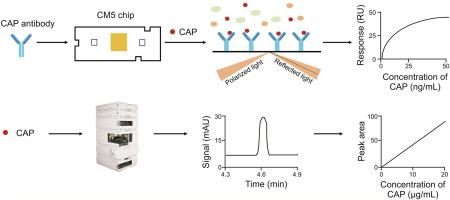Journal of Pharmaceutical Analysis ( IF 6.1 ) Pub Date : 2022-06-08 , DOI: 10.1016/j.jpha.2022.06.003 Minyu Qi , Diya Lv , Ying Zhang , Dongyao Wang , Xiaofei Chen , Zhenyu Zhu , Zhanying Hong , Yifeng Chai , Hai Zhang , Yan Cao

|
Therapeutic drug monitoring (TDM) has played an important role in clinical medicine for precise dosing. Currently, chromatographic technology and immunoassay detection are widely used in TDM and have met most of the needs of clinical drug therapy. However, some problems still exist in practical applications, such as complicated operation and the influence of endogenous substances. Surface plasmon resonance (SPR) has been applied to detect the concentrations of small molecules, including pesticide residues in crops and antibiotics in milk, which indicates its potential for in vivo drug detection. In this study, a new SPR-based biosensor for detecting chloramphenicol (CAP) in blood samples was developed and validated using methodological verification, including precision, accuracy, matrix effect, and extraction recovery rate, and compared with the classic ultra-performance liquid chromatography-ultraviolet (UPLC-UV) method. The detection range of SPR was 0.1–50 ng/mL and the limit of detection was 0.099 ± 0.023 ng/mL, which was lower than that of UPLC-UV. The intra-day and inter-day accuracies of SPR were 98%–114% and 110%–122%, which met the analysis requirement. The results show that the SPR biosensor is identical to UPLC-UV in the detection of CAP in rat blood samples; moreover, the SPR biosensor has better sensitivity. Therefore, the present study shows that SPR technology can be used for the detection of small molecules in the blood samples and has the potential to become a method for therapeutic drug monitoring.
中文翻译:

开发用于准确、灵敏地定量血液样本中小分子的表面等离子体共振生物传感器
治疗药物监测 (TDM) 在临床医学精确给药方面发挥了重要作用。目前,层析技术和免疫分析检测广泛应用于TDM,已经满足了临床药物治疗的大部分需求。但在实际应用中仍存在操作复杂、受内源性物质影响等问题。表面等离子共振(SPR)已被应用于检测小分子的浓度,包括农作物中的农药残留和牛奶中的抗生素,表明其在体内药物检测方面的潜力。在这项研究中,开发了一种基于 SPR 的新型生物传感器,用于检测血液样本中的氯霉素 (CAP),并使用方法验证进行了验证,包括精密度、准确度、基质效应和提取回收率,并与经典的超高效液相色谱-紫外 (UPLC-UV) 方法进行了比较。SPR 的检测范围为 0.1–50 ng/mL,检测限为 0.099 ± 0.023 ng/mL,低于 UPLC-UV。SPR的日内和日间准确度分别为98%~114%和110%~122%,满足分析要求。结果表明,SPR生物传感器与UPLC-UV对大鼠血样中CAP的检测效果相同;此外,SPR生物传感器具有更好的灵敏度。因此,本研究表明,SPR技术可用于检测血样中的小分子物质,具有成为治疗药物监测方法的潜力。099 ± 0.023 ng/mL,低于 UPLC-UV。SPR的日内和日间准确度分别为98%~114%和110%~122%,满足分析要求。结果表明,SPR生物传感器与UPLC-UV对大鼠血样中CAP的检测效果相同;此外,SPR生物传感器具有更好的灵敏度。因此,本研究表明,SPR技术可用于检测血样中的小分子物质,具有成为治疗药物监测方法的潜力。099 ± 0.023 ng/mL,低于 UPLC-UV。SPR的日内和日间准确度分别为98%~114%和110%~122%,满足分析要求。结果表明,SPR生物传感器与UPLC-UV对大鼠血样中CAP的检测效果相同;此外,SPR生物传感器具有更好的灵敏度。因此,本研究表明,SPR技术可用于检测血样中的小分子物质,具有成为治疗药物监测方法的潜力。











































 京公网安备 11010802027423号
京公网安备 11010802027423号